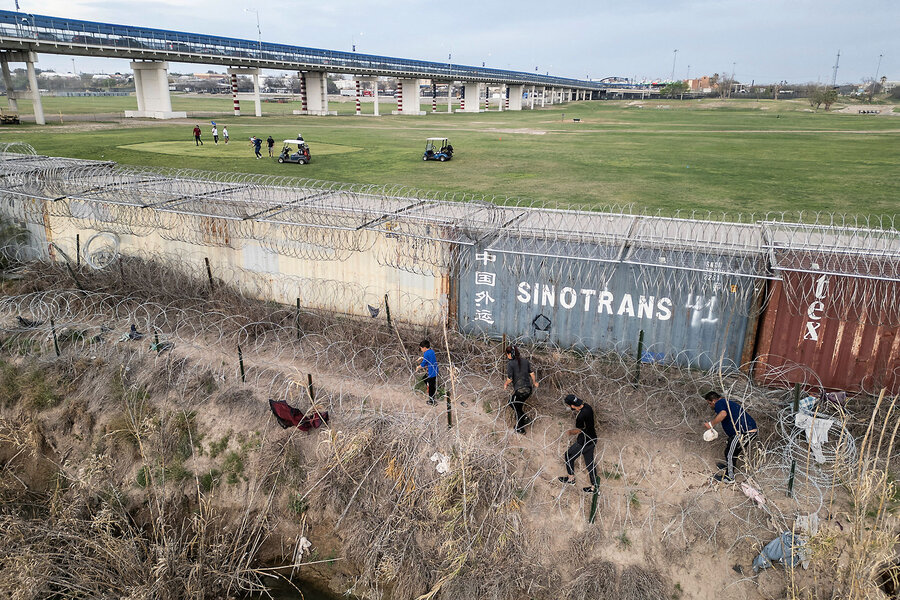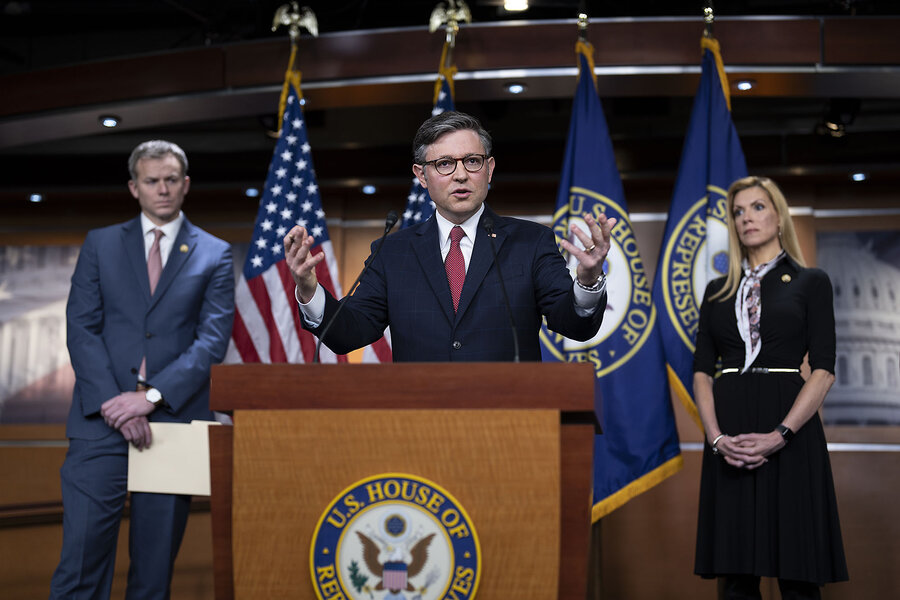Biden versus Trump: Will Texas visits reframe border blame game?
Loading...
| Brownsville, Texas
President Joe Biden and former President Donald Trump made dueling visits to the U.S.-Mexico border on Thursday, each trying to shape the narrative on what’s become the biggest issue of the 2024 campaign.
Illegal crossings have hit historic highs on Mr. Biden’s watch, and immigration now tops the list of Americans’ concerns, ahead of inflation. It’s also a serious political liability for the president: Nearly two-thirds of voters currently disapprove of Mr. Biden’s handling of immigration. Mr. Trump, who has long made border security one of his signature issues, has been relentlessly trying to capitalize on that weakness, accusing the president of refusing to take steps within his power to stem the tide of migrants.
Why We Wrote This
Same-day border visits by both presidential front-runners underscore how illegal immigration has become the top issue in the race. In a marked change, President Joe Biden is going on the offensive.
But the political dynamic may have shifted somewhat after Mr. Trump pushed Senate Republicans to kill a bipartisan deal to beef up border security earlier this month – giving Democrats a rare opening to go on the offensive and argue that Republicans care more about winning elections than about actually fixing the situation.
Republicans “run the risk of being painted as obstructionist,” says Dave Wasserman, senior editor and elections analyst with the Cook Political Report. He adds, “It’s up to the president and his campaign to prosecute that case.”
President Joe Biden and former President Donald Trump made dueling visits to the U.S.-Mexico border on Thursday, each trying to shape the narrative on what’s become the biggest issue of the 2024 campaign.
Illegal crossings have hit historic highs on Mr. Biden’s watch, and immigration now tops the list of Americans’ concerns, ahead of inflation. It’s also a serious political liability for the president: Nearly two-thirds of voters currently disapprove of Mr. Biden’s handling of immigration. Mr. Trump, who has long made border security one of his signature issues, has been relentlessly trying to capitalize on that weakness, accusing the president of refusing to take steps within his power to stem the tide of migrants.
But the political dynamic may have shifted somewhat after Mr. Trump urged Senate Republicans to kill a bipartisan deal to beef up border security earlier this month – giving Democrats a rare opening to try to go on the offensive. Republicans had originally pushed for the border bill, which included a number of provisions favored by conservatives, but abruptly withdrew their support after Mr. Trump signaled his disapproval.
Why We Wrote This
Same-day border visits by both presidential front-runners underscore how illegal immigration has become the top issue in the race. In a marked change, President Joe Biden is going on the offensive.
After landing Thursday afternoon in Brownsville, Texas, Mr. Biden headed straight to the border, his motorcade bumping along a dirt road paralleled by a 20-foot fence. The president, dressed in a sport coat and baseball cap, got out near a landing on the Rio Grande and talked with a small group of Border Patrol agents, flanked by Secretary of Homeland Security Alejandro Mayorkas. His motorcade then continued on to the Brownsville Border Patrol station for a press conference, passing cars with Trump flags and a handwritten sign that read, “No Mas Joe” (“No More Joe”).
“We need to act,” said Mr. Biden, asking GOP House Speaker Mike Johnson and his Republican colleagues to “show a little spine” and pass the bipartisan border bill, which he called a win for the American people.
Mr. Biden’s move, coming just a week before his State of the Union speech, echoes an approach mapped out by Rep. Tom Suozzi, a centrist Democrat who won a New York special election this month. Instead of running away from his opponent’s attacks on immigration, Mr. Suozzi leaned into the issue, highlighting his support for the border security bill in Washington and calling out Republicans for refusing to fix the problem when given the chance.
Strategists say the president has a far deeper hole to dig himself out of, and voter perceptions can be hard to change three-plus years into a presidency. Still, they add, Mr. Biden does not need to beat Mr. Trump on this issue – he would likely benefit simply from muddying the waters, and convincing some portion of voters that Republican obstruction is as much to blame for the situation as his own policies.
“I would tell any Democrat now – pull a Harry Truman,” says New York political consultant Jay Townsend, referring to President Truman’s successful reelection strategy of blaming a “do-nothing” Congress. Republican lawmakers gave Mr. Biden a gift by killing the border bill, he says – an opportunity to try to turn lemons into lemonade. “Frankly, it’s one of the few options they have,” he adds, “but it’s a potent option.”
How to fix “chaos” at the border?
While Republicans have long criticized the president and Vice President Kamala Harris for making only a handful of trips to the border, the lack of photo-ops aren’t the issue, says GOP operative Matt Mackowiak of Potomac Strategy Group, who splits his time between Washington and Texas.
“The issue is not whether he’s been to the border enough; the issue is the reality on the border and how [Mr. Biden’s] policies are contributing to the chaos that we’re seeing,” he says. “The only thing that voters are going to look at is whether the border is getting better or not.”
Since Mr. Biden took office in 2021, the average number of Border Patrol encounters with migrants crossing the border between official ports of entry has more than quadrupled compared with the Trump years. That’s in part due to higher rates of migrants attempting to cross multiple times, but the upward trend is undeniable. Illegal immigration has reached record levels under Mr. Biden, even compared with the 1980s, when there were also high recidivism rates.
Nearly 400 miles northwest of Brownsville, Mr. Trump visited Eagle Pass, Texas, where the state’s recent efforts to bolster physical barriers to stem the flow of migrants led to a stand-off with the federal government. In contrast with Mr. Biden, Mr. Trump chose to deliver his public remarks right on the border, with the Rio Grande and Mexico beyond as his backdrop. Flanked by Texas Gov. Greg Abbott, he recited a list of his border policies, arguing the border was far more secure under his watch. “This is a Joe Biden invasion,” he said.
He seized on the murder of nursing student Laken Riley last week in Georgia, in which suspect Jose Ibarra is a Venezuelan man who crossed the border illegally in 2022 and was paroled into the country.
The GOP blames the spike in border crossings on Mr. Biden’s reversal of executive actions that Mr. Trump had implemented, describing the former president’s measures as effective tools to disincentivize and block illegal crossings. Initially, the Biden administration dismissed the GOP attacks – accompanied by nonstop video clips of migrants streaming across the Rio Grande on Fox News and other conservative outlets – as little more than political propaganda.
But when Governor Abbott began busing migrants from Texas to cities like Chicago and New York in 2022, he successfully expanded the issue beyond border states and GOP talking points. Democratic mayors and governors also began calling on the president to take stronger steps, as the stream of migrants taxed their budgets – and patience.
“We are past our breaking point,” New York City Mayor Eric Adams said in August, noting that the city had absorbed more than 100,000 asylum seekers in the past year and predicting an additional $12 billion in costs over the next three years if current trends continued. “The federal government must take action.”
By January, a Harvard/Harris poll showed immigration was the No. 1 concern of voters – and the issue on which Mr. Biden had the lowest approval rating.
Then came the border security deal. On the defensive, Democrats agreed to Republican demands for stricter border policies, tied to tens of billions of dollars in aid to Ukraine and Israel. The lead GOP negotiator on the deal, Sen. James Lankford of Oklahoma, touted the eventual bill as a “a once-in-a-generation opportunity to close our open border.” It had provisions to tighten asylum policy and give the president stepped-up border enforcement tools. Unlike previous bipartisan efforts, it did not include any sort of amnesty or path to legalization for unauthorized immigrants already living in the U.S.
But Mr. Trump slammed the measure as an electoral “gift” to the Democrats, saying: “They need it politically.” House Speaker Mike Johnson called it “dead on arrival,” and said the Democratic-controlled Senate should have taken up Republicans’ much more stringent border bill, H.R. 2. And Senate Republicans also turned their backs on the deal after Mr. Trump weighed in.
Dave Wasserman, senior editor and elections analyst with The Cook Political Report, says Republicans’ about-face was understandable, given that there is a good chance they could control more levers of power by next year. And with the election just nine months away, they have little incentive to help Mr. Biden neutralize a political weakness.
Still, the bill’s sudden demise gave Democrats a chance to argue that Republicans care more about winning elections than actually fixing the situation at the border. Republicans “run the risk of being painted as obstructionist,” Mr. Wasserman says, adding: “It’s up to the president and his campaign to prosecute that case.”
Senior congressional correspondent Christa Case Bryant reported from Washington.










